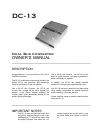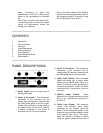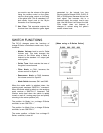
• When connecting a guitar and
synthesizer(s) to the DC-13, be sure that
power to the synthesizer(s) is switched
off.
• The 13-pin connectors used with the DC-
13 are locking style, and therefore cables
cannot be disconnected unless the
locking pin is released.
• Due to the unique design of the VG-88, a
low level hum may be heard when the VG-
88 is used as Synth B. If this occurs, plug
the VG-88 into the Synth A jack.
_______________________________________
CONTENTS
1. Description
1. Important Notes
2. Contents
2. Panel Descriptions
3. Switch Functions
4. Synth Selection
4. Synth Selection (Both)
4. Specifications
_______________________________________
PANEL DESCRIPTIONS
1. Guitar Input: Input for 24-pin style G-
Series guitar cable.
2. Synth A Connector: The synthesizer
connected to this connector can be
played when [A] has been selected with
the [A/B] pedal switch on the top panel.
Please note that Synth A is also used as
the power source for the DC-13. Without
a device connected to the Synth A
connector, the DC-13 will not operate.
3. Synth B Connector: The synthesizer
connected to this connector can be
played when [B] has been selected with
the [A/B] pedal switch on the top panel.
4. [A/B] Pedal Switch: This is the pedal
switch that allows you to select which
device is to be played, either Synth A or
Synth B. If there is nothing connected to
the Synth B connector, the DC-13 will still
function as a BC-13 style 24 to 13 pin bus
converter.
5. [BOTH] Pedal Switch: When
switched ON, this pedal allows you to play
both of the synthesizers connected to
the DC-13.
6. Guitar Line Output: This connector
outputs the line-level guitar signal
generated by the pickups inside the
guitar. You can change the quality of this
sound by using the pickup selector switch
or the guitar’s tone control. This output
does not
respond to changes in volume
using the guitar’s master volume knob. If






